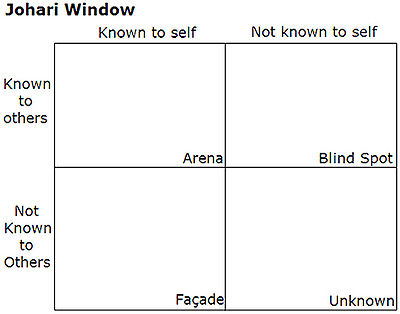The Johari Window
(→Abstract) |
(→The Four Quadrants) |
||
| Line 20: | Line 20: | ||
=== Arena === | === Arena === | ||
| + | Loft refers to the first quadrant as ''the area of free activity'' | ||
| + | |||
=== Façade === | === Façade === | ||
Revision as of 16:57, 7 February 2021
Contents |
Abstract
In the 1950s large, complex and interdisciplinary projects started to emerge. It was therefore evident that new materials, methods and procedures had to be developed to ensure the success of these projects. This allowed for development of new concepts in the Socio-technical arena, which focused on the interdisciplinary project team and how to evolve and develop these teams effectively[1]. In other words; the new complex and interdisciplinary projects paved the way for the soft skills and focus on behavior in individual and team development.
The Johari Window was developed by psychologists Joseph Luft and Harrington Ingram in 1955. It seeks to foster and improve self-awareness by providing the user with different perspectives in relation to context, and can be used on, but are not limited to, an individual or team level. In order for a person, or a team, to grow and mature, they must seek information from the outside in order to uncover their strength and weaknesses. This can for example be done either by comparing oneself to another person or team (individual level), or by comparing the team to other teams (teams level). When used and understood correctly, the Johari Window can help manage teams and individuals by creating an understanding of how they communicate, are perceived and present them self. For teams the Johari Window may result in a change of the group dynamic, as new information can be uncovered.
This article will start by introducing the reader to the history of the Johari Window, followed by an explanation of the four quadrants, and how these interplay with each other. The reader will then be introduced to ways of changing and broadening specific windows in order to become more self aware, and how to use the Johari Window for improving interdisciplinary teams. Lastly this article will provide the reader with different examples on the layout of the Johari Window and how to improve on these.
Background
The Johari Window was created by Joseph Luft and Harrington Ingram in 1961, and have since been interpreted and adapted for many different use cases. The name Johari comes from the two authors, how decided to name this model after them self (JOseph and HARrIngton). In 1961 Joseph Luft described the Johari Window as "a graphical model of awareness in interpersonal relations" [2]. It was originally designed to promote self-awareness and foster communication for development. Since the Johari Windows first saw the light of day, it has, by some, been used to gain a deeper insight into the world around us by analyzing knowledge and assumptions rather than individuals[3].
The Four Quadrants

The Johari Window consists of four quadrants;1) Arena, 2) Façade, 3) Blind Spot and 4) Unknown, which together illustrates the relationship of awareness. The four quadrants are categorised into a matrix system with two viewpoint: self and others, and two elements: known and unknown[4]. The Johari Window is often depicted in a way, where all of the quadrant have the same size. In reality, this is not the case, as the quadrant can change in size according to the amount of knowledge it reflects. This will be covered in a later chapter.
Arena
Loft refers to the first quadrant as the area of free activity
Façade
Blind Spot
Unknown
References
- ↑ Zûst, R. & Troxler, P. (2006). Communication. No More Muddling Through – Master Compelx Projects in Engineering and Management. Published by Springer Netherlands. ISBN: 978-1-4020-5018-3.
- ↑ Luft, J. The Johari Window: a graphical model of awareness in interpersonal relations. Retrieved 7 January 2021.
- ↑ Oliver, S. & Duncan, S. (2015). Editorial: Looking through the Johari window. Research for All. 3rd ed. UCL Press. 1-6.
- ↑ Lowes, R. (21 July 2020). Frontiers in Eduction. Vol. 5. 101.